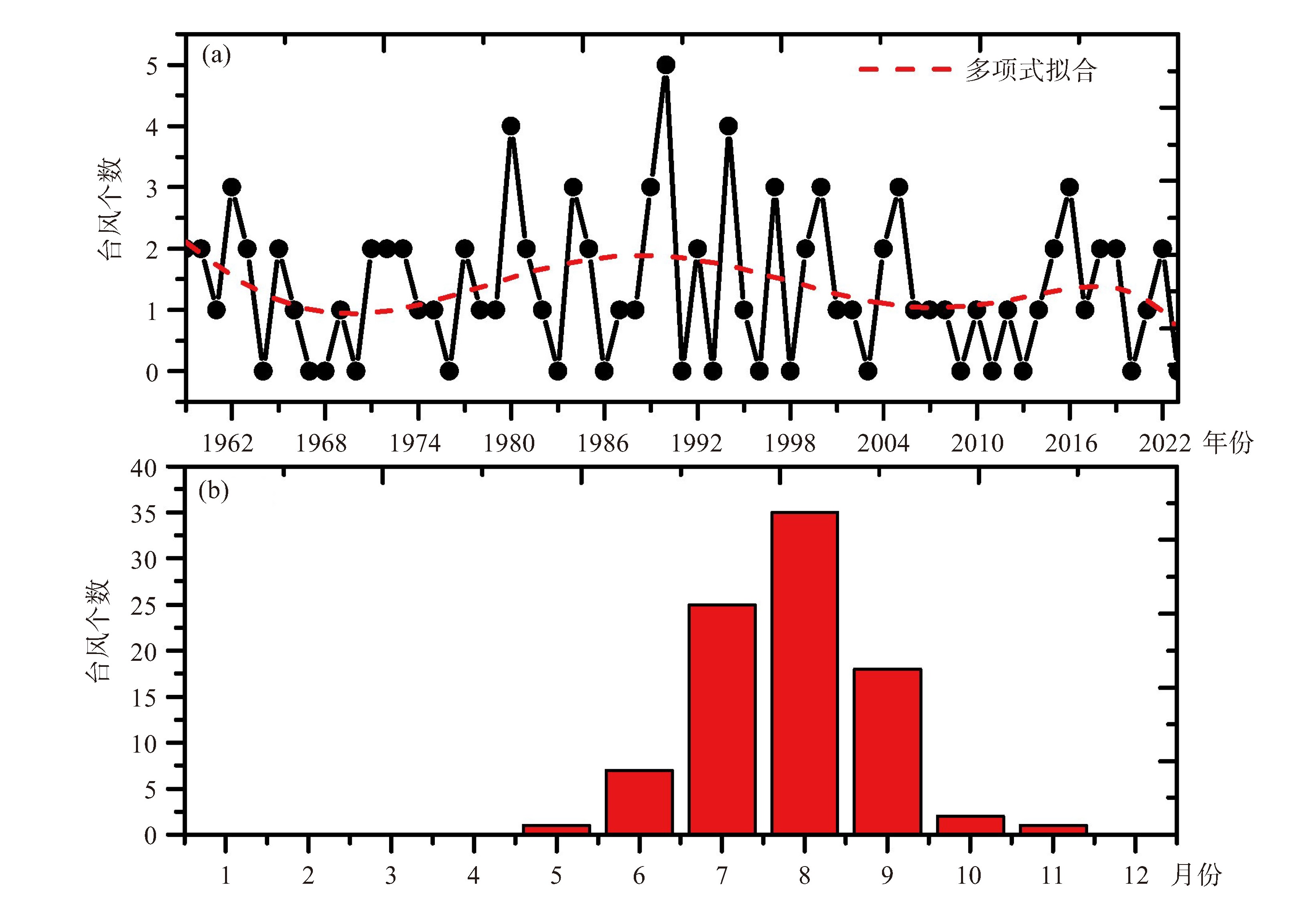Landing Path and Intensity Characteristics of Typhoons Affecting Hefei Area from 1959 to 2023
-
摘要: 台风引起的极端天气给内陆城市人民生命财产安全造成重大威胁,因此研究影响内陆城市的台风登陆特征十分重要。利用1959—2023年CMA热带气旋最佳路径数据集及地面观测资料,系统分析了影响合肥地区的台风登陆特征,并依据风雨影响差异将其划分为三类:仅降雨高影响型(OP)、仅大风高影响型(OW)和严重风雨复合型(PW)。研究结果表明:(1) 65年间共89个台风影响合肥,其中OP、OW和PW占比分别为17%、20%和8%,合计占45%,凸显高影响台风的重要地位;(2) 时间分布显示,台风活动呈阶段性变化,20世纪80年代—20世纪90年代及2016年后为活跃期;2000年前以OW为主,之后OP占比显著上升,而PW重现期为10~ 20年;季节上,7—9月为集中影响期(8—9月PW频次增加);(3) 登陆特征上,福建为最频登陆省份(31.2%),43.7%的台风存在二次登陆,其中94%首次登陆台湾后再次登陆同闽浙;登陆强度以台风级为主,但OW强度普遍弱于OP;(4) 移动路径中,48%的台风遵循第Ⅳ类路径(30 °N以南转向),而OP/PW和OW的第二主导路径分别为第Ⅱ类(西北型)和第Ⅲ类(北上转向型)。值得注意的是,江西省和苏浙皖交界区是高影响台风移动路径的关键过渡区,分别对应OP和OW的主要影响通道。研究结果为合肥市台风灾害风险评估和防御策略制定提供了数据支撑。Abstract: Extreme weather caused by typhoons poses significant threats to the lives and property of inland city residents. Therefore, studying the landfall characteristics of typhoons affecting inland cities has become increasingly important.The China Meteorological Administration (CMA) tropical cyclone best-track data and ground observation data from 1959 to 2023 were used to analyze the landfall characteristics of typhoons affecting Hefei Area. Based on wind-rain impact differences, the typhoons were divided into three categories: those with only high rainfall (OP), those with only strong winds (OW), and those with severe wind and rain (PW).The results show that: (1) Over 65 years, 89 typhoons affected Hefei. OP, OW, and PW accounted for 17%, 20%, and 8%, respectively, totaling 45% and highlighting the importance of highimpact typhoons. (2) Temporally, typhoon activity showed distinct phased changes, with active periods from the 1980s to 1990s and after 2016. Before 2000, OW events were predominant, while OP events increased significantly afterward. PW events had recurrence intervals of 10-20 years. Seasonally, July to September was the period of concentrated influence, with an increase in PW frequency from August to September. (3) In terms of landfall characteristics, Fujian was the most frequent landfall province (31.2%); 43.7% of typhoons underwent secondary landfalls, with 94% of them first making landfall in Taiwan before striking Fujian and Zhejiang. The landing intensity was mainly at the typhoon level, but OW strength was generally weaker than OP events. (4) In terms of movement paths, 48% followed a Type Ⅳ path (turning south of 30 °N), the secondary dominant paths for OP/PW and OW were Type Ⅱ (northwest) and Type Ⅲ (northward turning) while respectively, Significantly, Jiangxi Province and the JiangsuZhejiang-Anhui border region were key transitional zones for high-impact typhoon paths, corresponding to the main influence channels for OP and OW. The research results provide data support for the assessment of typhoon disaster risks and the formulation of defense strategies in Hefei.
-
表 1 1959—2023年影响合肥地区的台风在沿海省份的登陆频次及比例
登陆地点 首次/次 第2次/次 总计/次 登陆比例/% 福建 8 31 39 31.2 台湾 37 0 37 29.6 浙江 20 5 25 20.0 广东 13 1 14 11.2 上海 3 1 4 3.2 山东 2 0 2 1.6 香港 2 0 2 1.6 江苏 1 0 1 0.8 海南 1 0 1 0.8 总计 87 38 125 100.0 表 2 1959—2023年三类高影响台风在沿海省份的登陆频次及比例
台风类型 登陆顺序 登陆地点 总计 比例/% 福建 台湾 浙江 广东 上海 山东 香港 OP 首次 3 6 4 1 0 1 0 15 71.4 第2次 5 0 1 0 0 0 0 6 28.6 总计 8 6 5 1 0 1 0 21 100.0 比例/% 38.1 28.6 23.8 4.8 0 4.8 0 37.5 - OW 首次 2 8 4 1 1 0 1 17 65.4 第2次 8 0 1 0 0 0 0 9 34.6 总计 10 8 5 1 1 0 1 26 100.0 比例/% 40.0 32.0 20.0 4.0 4.0 0 4.0 46.4 - PW 首次 0 2 2 1 2 0 0 7 77.8 第2次 2 0 0 0 0 0 0 2 22.2 总计 2 2 2 1 2 0 0 9 100.0 比例/% 22.2 22.2 22.2 11.1 22.2 0 0 16.1 - 总计 首次 5 16 10 3 3 1 1 39 69.6 第2次 15 0 2 0 0 0 0 17 30.4 总计 20 16 12 3 3 1 1 56 100.0 比例/% 35.7 28.6 21.4 5.4 5.4 1.8 1.8 100.0 - -
[1] 毕雪岩, 刘春霞, 黄健, 等. 台风登陆过程中南海近海阵风因子特征[J]. 热带气象学报, 2022, 38(4): 502-510. [2] 常蕊, 朱蓉, 赵大军. 登陆台风影响下离地300m高度内的强风特征[J]. 大气科学, 2022, 46(5): 1 071-1 086. [3] TAKAHASHI T, KAWANO T. Numerical sensitivity study of rainband precipitation and evolution[J]. J Atmos Sci, 1998, 55(1): 57-87. [4] LONFAT M, ROGERS R, MARCHOK T. A parametric model for predicting hurricane rainfall[J]. Mon Wea Rev, 2007, 135(9): 3 086-3 097. [5] ROSS R J, KURIHARA Y. A numerical study on influences of Hurricane Gloria (1985) on the environment[J]. Mon Wea Rev, 1995, 123 (2): 332-346. [6] 丛春华, 陈联寿, 雷小途, 等. 台风远距离暴雨的研究进展[J]. 热带气象学报, 2011, 27(1): 264-270. [7] 廖玥, 王咏青, 周嘉陵. Chanchu台风(0601)精细结构中的熵流特征分析[J]. 热带气象学报, 2018, 34(5): 685-694. [8] DIMEGO G J, BOSART L F. The transformation of tropical storm agnes into an extratropical cyclone. Part Ⅰ: The observed fields and vertical motion computations[J]. Mon Wea Rev, 1982, 110(5): 385-411. [9] 庞琦烨, 平凡, 沈新勇. 不同微物理方案对台风彩虹(2015)降水影响的比较研究[J]. 大气科学, 2019, 43(1): 202-220. [10] 薛一迪, 崔晓鹏. 威马逊(1409)强降水物理过程模拟诊断研究[J]. 大气科学, 2020, 44(6): 1 320-1 336. [11] HARR P A, ELSBERRY R L. Tropical cyclone track characteristics as a function of large-scale circulation anomalies[J]. Mon Wea Rev, 1991, 119(6): 1 448-1 468. [12] LI Y, GUO L X, XU Y L. Impacts of upper-level cold vortex on the rapid change of intensity and motion of Typhoon Meranti[J]. J Trop Meteorol, 2012, 18(2): 207-219. [13] 陈联寿, 丁一汇. 西太平洋台风概论[M]. 北京: 科学出版社, 1979: 1-491. [14] 孙佳, 王燕妮, 左军成. 江浙沿海台风特征分析[J]. 河海大学学报(自然科学版), 2015(5): 215-221. [15] 饶晨泓, 毕鑫鑫, 陈光华. 近海台风对21·7河南极端暴雨过程水汽通量和动、热力条件影响的模拟[J]. 大气科学, 2022, 46(6): 1 577- 1 594. [16] 杨舒楠, 张芳华, 胡艺, 等. "23·7"华北特大暴雨过程的基本特征与成因初探[J]. 暴雨灾害, 2023, 42(5): 508-520. [17] 侯建忠, 王川, 鲁渊平, 等. 台风活动与陕西极端暴雨的相关特征分析[J]. 热带气象学报, 2006, 22(2): 203-208. [18] 白莉娜, 王元. 南海源地热带气旋生成和登陆频数的气候变异[J]. 南京大学学报(自然科学版), 2009, 45(6): 757-768. [19] ANDY Z C G, CHAN J C L. Interannual and interdecadal variations of tropical cyclone activity in the South China Sea[J]. Int J Climatol, 2010, 30(6): 827-843. [20] 孙秀荣, 端义宏. 对东亚夏季风与西北太平洋热带气旋频数关系的初步分析[J]. 大气科学, 2003, 27(1): 67-74. [21] 江文, 王东海, 张春燕, 等. 近70年不同路径的南海热带气旋的统计特征[J]. 热带气象学报, 2022, 38(3): 433-443. [22] WANG C, WANG X. El Nino Modoki Ⅰ and Ⅱ by different impacts on rainfall in Southern China and typhoon tracks[J]. J Climate, 2013, 26 (4): 1 322-1 338. [23] 李春晖, 刘春霞, 程正泉. 近50年南海热带气旋时空分布特征及其海洋影响因子[J]. 热带气象学报, 2007, 23(4): 341-347. [24] LIU K S, CHAN J C L. Climatological characteristics and seasonal forecasting of tropical cyclones making landfall along the South China coast[J]. Mon Wea Rev, 2003, 131(8): 650-662. [25] 谢佩妍, 陶丽, 李俊徽, 等. 西北太平洋热带气旋在ENSO发展和衰减年的路径变化[J]. 大气科学, 2018, 42(5): 987-999. [26] 邢蕊, 徐晶, 林瀚. 热带气旋过台湾后再次登陆的路径强度变化统计分析[J]. 气象, 2020, 46(4): 517-527. [27] 任丽, 王晓雪, 张桂华. 近60年黑龙江省台风暴雨统计及环流特征分析[J]. 热带气象学报, 2023, 39(2): 159-170. [28] 曹钢锋, 朱官忠, 朱君鉴. 影响我国北方的台风路径分类及降水特征[J]. 气象, 1992, 18(7): 12-16. [29] 王坚红, 姜云雁, 崔晓鹏, 等. 1956~2012年浙闽登陆热带气旋降水精细化观测统计分析[J]. 大气科学, 2018, 42 (1): 16-32. [30] 刘婧茹, 李英, 孟青. 中国东南地区热带气旋大风及其伴随天气的统计特征[J]. 大气科学, 2023, 47(4): 1 024-1 038. [31] YING M, ZHANG W, YU H. An overview of the China Meteorological Administration tropical cyclone database[J]. J Atmos Oceanic Technol, 2014, 31(2): 287-301. [32] LU X, YU H, YING M. Western North Pacific tropical cyclone database created by the China Meteorological Administration[J]. Adv Atmos Sci, 2021, 38(4): 690-699. [33] 端义宏. 登陆台风异常变化机理[M]. 北京: 科学出版社, 2022: 1-960. [34] 王东勇. 近60年不同类别登陆台风对安徽省降雨影响[M]. 北京: 气象出版社, 2020: 1-336. [35] 于龙, 孙佳, 回贞立. 西行穿越南海台风的特征及机制研究[J]. 海洋科学进展, 2019: 37(4). [36] CHEN X, WANG Y, ZHAO K. Synoptic flow patterns and large-scale characteristics associated with rapidly intensifying tropical cyclones in the South China Sea[J]. Mon Wea Rev, 2014, 143(1): 64-87. [37] 何玉秀, 许有鹏, 李子贻. 城镇化对极端降水的影响及其贡献率研究——以太湖平原地区为例[J]. 湖泊科学, 2022, 34(1): 262-271. -






 下载:
下载:









 粤公网安备 4401069904700003号
粤公网安备 4401069904700003号